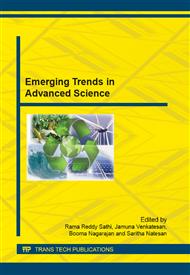[1]
J.M. Burdio, L.A. Barragan, F. Monterde, D. Navarro, and J. Acero, Asymetrical voltage cancellation control for full-bridge series resonant inverters, IEEE Trans. On Power Electronics, vol. 19, no. 2, pp.461-469,(2004).
DOI: 10.1109/tpel.2003.823250
Google Scholar
[2]
J. Acero, R. Alonso, J.M. Burdio, L.A. Barragan and D. Puyal, Frequency-dependent resistance in Litz-wire planar windings for domestic induction heating appliances, Power Electronics, IEEE Transactions on, vol. 21, pp.856-866, (2008).
DOI: 10.1109/tpel.2006.876894
Google Scholar
[3]
J. Acero, J.M. Burdío, L.A. Barragán, J.I. Artigas, R. Alonso,An electromagnetic-based model for calculating the efficiency in domestic induction heating appliances, in IEEE Proc. Power Electron. Spec. Conf (PESC), pp.1411-1416, (2007).
DOI: 10.1109/pesc.2006.1711755
Google Scholar
[4]
J. Acero, J.M. Burdío, L.A. Barragán, J.I. Artigas, C. Carretero, A model of losses in twisted-multistranded wires for planar windings used in domestic induction heating appliances, in Proc. IEEE Appl. Power Electron. Conf. (APEC), pp.81-85 (2007).
DOI: 10.1109/apex.2007.357674
Google Scholar
[5]
Jamila essadaoui, Pierre sicard,Eloi Ngandui, Ahmed Cheriti, Power inverter control for induction heating by pulse density modulation with improved power factor, in proc. Of CCGEI 2003, p.69-p.74, (2003).
DOI: 10.1109/ccece.2003.1226449
Google Scholar
[6]
O. Lucía, I. Millán, J. M. Burdio, S. Llorente, and D. Puyal, Control algorithm of half-bridge series resonant inverter with different loads for domestic induction heating, in International Symposium on Heating by Electromagnetic Sources, pp.107-114 (2008).
DOI: 10.1109/isie.2007.4374719
Google Scholar
[7]
Millán, I. Burdío, J.M. Acero, J. Lucía, O. Palacios, Resonant inverter topologies for three concentric planar windings applied to domestic induction heating, IEEE Electronics Letters, Vol. 46 no 17, pp.1225-1226, (2010).
DOI: 10.1049/el.2010.1197
Google Scholar
[8]
Acero,. Jburdio, J.M., Domestic induction appliances: an overview of recent research, in IEEE Ind Appl. pp.39-47, (2010).
Google Scholar
[9]
Yiwang Wang, Study of Induction Heating Power Supply Based on Fuzzy Controller, 978-1-4244-2800-7/09, IEEE, (2009).
DOI: 10.1109/iciea.2009.5138300
Google Scholar
[10]
J. M. Burdio, L. A Barragan, F. Monterde, D. Navarro, and J. Acero, Asymmetrical voltagecancellation control for full-bridge series resonant inverters, IEEE Trans. Power Electron. , vol. 19, no. 2, pp.461-469, (2010).
DOI: 10.1109/tpel.2003.823250
Google Scholar
[11]
O. Lucía, F. Almazám, J. Acero, J. M. Burdío, and C. Carretero, Multiple-output resonant matrix converter for multiple-inductive-load system, in Proc. 26th Annu. IEEE APEC, 2011, p.1338–1343, (2013).
DOI: 10.1109/apec.2011.5744765
Google Scholar
[12]
O. Lucia, J. M. Burdio, L. A. Barragan, C. Carretero, and J. Acero, Series resonant multiinverter with discontinuous mode control for improved light-load operation, IEEE Trans. Ind. Electron., 58, p.5163–5171, (2014).
DOI: 10.1109/tie.2011.2126541
Google Scholar


